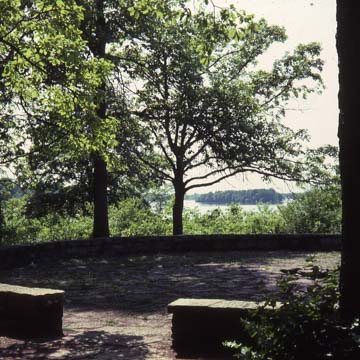The Garden Club of Illinois, in collaboration with Harriet Knudson and the Springfield Civic Garden Club, created the Lincoln Memorial Garden as a living memorial to the sixteenth president in the town he called home. Noted Danish-American landscape architect Jens Jensen designed the garden near the end of his long and illustrious career, and it is one of the finest expressions of his vision for reconnecting people with their natural heritage.
The Garden is located on the south shore of Lake Springfield, a reservoir created by Springfield City Water, Light, and Power in 1931–1935 to provide drinking water for the city of Springfield and surrounding communities. At the time of construction, the property, well outside of Springfield’s developed center, was part of the large Ostermeier Farm (c. 1850) and consisted of former farm fields with scant trees growing in old fencerows. Today, parks and residential development surround the lake.
As a living memorial to Abraham Lincoln, the Garden was intended to include many of the natural habitats Lincoln would have known during his lifetime. It can be regarded as an early experiment in ecological restoration, akin to the University of Wisconsin Arboretum, with its pioneering effort to restore the state’s prairie and forest habitats. Jensen’s design sought to transform the park’s original sixty-three acres to native prairie, wetland, and woodland habitats. Though Jensen completed his scheme for the park in 1936, he continued to advise Knudson on the implementation of his design until he died in 1951.
The project required a creative approach to planting, as many of the desired native plants were not readily available from nurseries. Schoolchildren were recruited to collect acorns, and garden club volunteers, workers from the Works Progress Administration (WPA), and others planted saplings as part of the initial restoration work. Later, garden club members across Illinois were recruited to rescue native wildflowers for planting in the developing woodland understory.
Key features of Jensen’s plan included gentle hiking trails, long “fingers” of prairie meadows between blocks of woodland, and eight council rings to serve as gathering places. The idea of council rings grew out of Jensen’s own experience of gathering around campfires on the beach in his native Denmark and his fascination with Native American traditions of gathering around a council fire. In Jensen’s mind, gathering around a circle for discussion, storytelling, and other activities was particularly democratic, as each participant would be on the same level. At Lincoln Memorial Garden, the eight council rings are built of rough limestone and set at distinctive places throughout the garden—each with a unique setting. One is a half-circle, open to views of a wetland and stream draining towards the lake. The largest, Lincoln Council Ring, is set on a slight rise in a grove of white oak and provides commanding views of the lake. Jensen noted the white oak as a fitting tribute to Lincoln, suggesting that given the tree’s long lifespan, it would be a longer lasting tribute to the late president than statues and monuments.
In recent years, Lincoln Memorial Garden has expanded its holdings to over 100 acres. The additional acreage has provided much needed parking near the entrance and additional locations for a wide variety of nature-based activities. It remains one of the best examples of Jensen’s artistry and a much-loved center for nature-based education in Central Illinois.
References
Eaton, Leonard K. Landscape Artist in America: The Life and Work of Jens Jensen. Chicago: University of Chicago Press, 1964.
Grese, Robert E. Jens Jensen: Maker of Natural Parks and Gardens.Baltimore, MD: Johns Hopkins University Press, 1992.
Groves, Judith, and Melinda Kwedar. “Abraham Lincoln Memorial Garden: Interview with Berta Cochran, Margaret Gaule, Molly Gray, Homer McLaren, Jeanette Sayre, and Milton Thompson.” 1972 and 1975. Oral History Office, Sangamon State University, Springfield, IL.
Lincoln Memorial Garden Archives, Springfield, IL.










